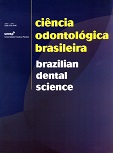Influência do consumo crônico de álcool etílico na morfologia de ossos longos em ratas adultas jovens
DOI:
https://doi.org/10.14295/bds.2007.v10i1.415Abstract
A ingestão crônica de álcool pode provocar alterações estruturais em vários tecidos, inclusive no tecido ósseo. O objetivo desse estudo foi avaliar o efeito da ingestão de álcool etílico sobre a morfometria de fêmures e tíbias em ratas. Foram utilizados quarenta animais (4 meses de idade) divididos em cinco grupos (n=8) conforme a dieta líquida administrada: água (Gc-controle), solução alcoólica a 10% (GA1), solução de sacarose a 13,5% (GI1), solução alcoólica a 20% (GA2), solução de sacarose a 27% (GI2). Os grupos GI1 e GI2 receberam dietas controladas com mesmo valor calórico dos grupos GA1 e GA2, respectivamente. Após oito semanas, os animais foram sacrificados e os fêmures e tíbias removidos. O peso úmido dos espécimes foi avaliado em balança analítica. O comprimento e diâmetros (ântero-posterior e médio-lateral) foram medidos com paquímetro digital. Após, foram realizadas radiografias na metade distal dos espécimes para determinar a localização do tecido ósseo trabecular. Nesta região, secções transversais (1 mm) foram obtidas, em local padronizado, a fim de avaliar o percentual médio da área óssea cortical e medular. A análise estatística (ANOVA) não revelou diferenças significativas (P>0,05) para comprimento, diâmetro médio-lateral, diâmetro ântero-posterior e valores percentuais de área óssea cortical e área óssea medular. Pode-se concluir que o consumo de álcool etílico a 10% (que correspondeu a 24,36% das calorias diárias da dieta) e 20% (que correspondeu a 40,10% das calorias diárias da dieta) durante oito semanas em ratas adultas jovens não promoveu alterações morfológicas nos ossos longos.Downloads
Downloads
Published
How to Cite
Issue
Section
License
Brazilian Dental Science uses the Creative Commons (CC-BY 4.0) license, thus preserving the integrity of articles in an open access environment. The journal allows the author to retain publishing rights without restrictions.
=================




























